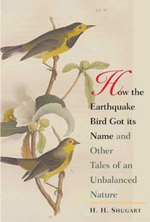Review of "How the Earthquake Bird Got Its Name and Other Tales of an Unbalanced Nature"

Author(s): H.H. Shugart
Published: November 2004, Yale University Press, ISBN: 030010457X
 by James A. Huggins, Ph.D., University Professor & Director of the Hammons Center for Scientific Studies
by James A. Huggins, Ph.D., University Professor & Director of the Hammons Center for Scientific Studies
June 154, 2005 -
The design of our world is such that there is a tremendous interconnectedness of life forms and ecological disturbances ripple like waves from a rock in a pond across the ecosystems and biomes of our planet. The story told in this book is one of change and the fragility of species survival. This narrative reminds us, particularly those of us that are Christian, that we must all be global ecologists to some extent. The reason is that as humans we, intentionally or unintentionally and like it or not, manage the biotic inventory of our planet through the environmental decisions that we make. Shugart’s use of modern day parables to illustrate the depth and breadth of human influence on the earth’s landscape is masterful. His choice of examples provides a cross section traversing time as well as flora and fauna. He successfully uses the extinct and the extant, the opportunist and the specialist, the predator and the prey, the domesticated and the feral, the plentiful and the endangered to weave a vision of the ecological processes at work on this planet. These same illustrations probe the depths of the ecological problem, broadly illustrate the crisis we face and, to the immense credit of the author, provide a grand set of case studies which soberly but profoundly instruct the student of the environment. His command of the subject is evident whether discussing the gap-replacement dynamics of succession or the ability for Neotoma midden analysis to convey information from the past.
The author points out that as early as 1914 human desire to be fashionable drove species such as the passenger pigeon into extinction and nearly did so for several other avian species. Even the now plentiful beaver, in an effort to meet market demand for the fashionable beaver hat in England, was nearly extricated from the continental United States. Economic decisions drive we humans and, often to its detriment, our environment is simply in tow. No longer can we afford to simply note that the environment is or has been “along for the ride” but it must become a part of our steering mechanism. It is time that the environment, as it does in the majority of other species, is allowed at least a share of the driver’s seat. Niche and habitat are not formed overnight. Time is an essential for the formation of a mature hardwood forest. It is perhaps true that a mature forest once gone can be reinstituted but what of the hosts of other organisms that depended upon it for survival? We do not have the time, or perchance even the Creator’s approval, to replenish these species. Niche specialists, and particularly the larger creatures of this category, are in severe danger when humans begin to commandeer the use of their environs. Such is the predicament for creatures such as the ivory-billed and the red-cockaded woodpeckers, the white rhino, the grizzly bear, and the eastern puma which are only able to meet their dietary and reproductive needs over large territories. Human populations require space in which to live; other creatures are no different.
For those of you interested in the animals Shugart uses for the purposes of illustration, the following species are representative but not exhaustive: ivory-billed woodpecker, great auk, passenger pigeon, Stephens Island wren, woodrat, Bachman’s warbler, beaver, Leadbeater’s possum, red-billed quelea, giant moa, dingo, Tasmanian wolf, hare, and the California thrasher. Even more impressive are the concepts Shugart explicates from his parables of God’s creatures: gap-replacement dynamics, Eltonian and Grinellian niche theory, indicator species, keystone species, ecological scales, habitat management practice and modeling, ecological convergence, population dynamics, and landscape dynamics coupled with environmental change. As before the previous list is merely representative of the scope of this tutoring session. Additionally, he addresses such important topics as the similarity of patterns across space and time, the importance of applying the appropriate spatial and temporal scales to answer given questions, the use of palynology, the fallacy of the common avowal of the “balance of nature”, megafaunal habitat alterations and extinctions, domestication as a stone age technology, exotic species invasions, and the proclivities of island biogeography.
The study of biology has certainly allowed us to understand the reasons for the demise of many species and it has provided the tools by which we may be able to rescue some from extinction. Unfortunately, as pointed out by Jon Coleman in Vicious, his historical account of the wolf in the Americas, an increase in knowledge has not been accompanied by concomitant and appropriate attempts to salvage our relationship with nature and the ecological processes our planetary home. This is not to imply that we know all that we need to insure the restoration of our planet or even to put it into a holding pattern for that matter. It does mean that we have been negligent in our duty to “keep” this planet. As the dominant species and the only species capable of reversing the human-mediated damage to our ecosystems, we should apply our use of technology and our considerable knowledge of the workings of ecology in a heretofore unprecedented effort to exert and accomplish some meaningful form of planetary stewardship.
This book is an interesting read and a biology text rolled into one. Every biology professor should learn the value of using such parables and each student of biology should take the time to examine and comprehend its contents!

